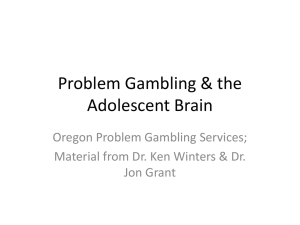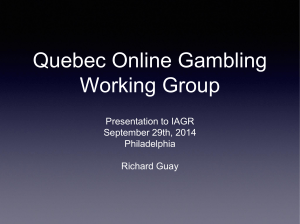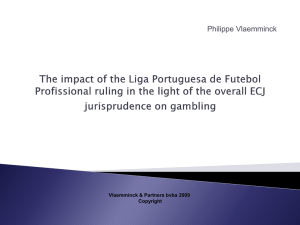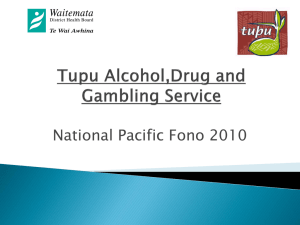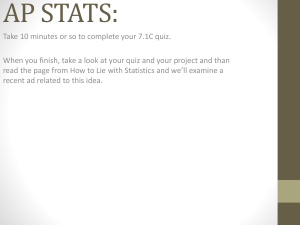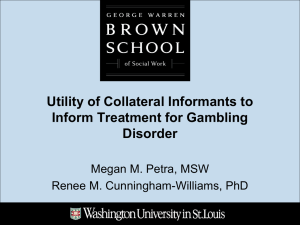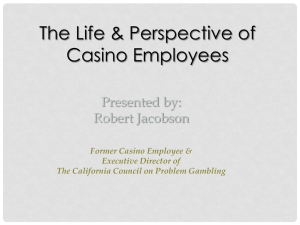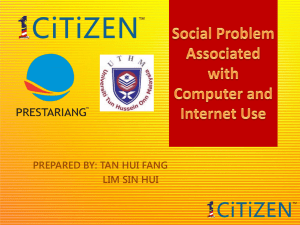Gambling: The Hidden Addiction - Maryland Addictions Directors
advertisement
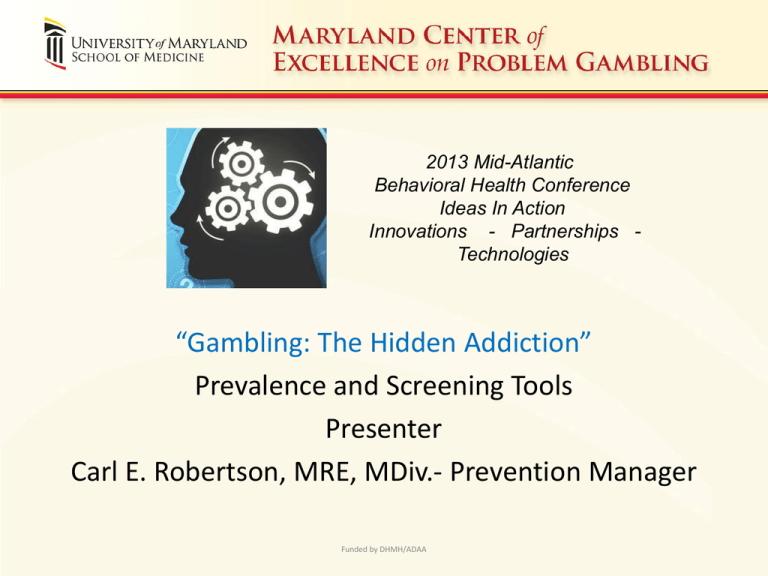
2013 Mid-Atlantic Behavioral Health Conference Ideas In Action Innovations - Partnerships Technologies “Gambling: The Hidden Addiction” Prevalence and Screening Tools Presenter Carl E. Robertson, MRE, MDiv.- Prevention Manager Funded by DHMH/ADAA Maryland Center of Excellence on Problem Gambling Partnership of Maryland Council on Problem Gambling and the University of Maryland School of Medicine Funded with a 3 year grant (2012-2015 ) from State Health Department Purpose: Identify and promote problem gambling treatment resources Provide Maryland based prevention and research initiatives Establish problem gambling lending library resources Conduct Public and Professional Awareness Outreach Campaigns Manage Maryland Problem Gambling Hotline: 1-800-522-4700 Funded by DHMH/ADAA • If you bet on a horse, that’s gambling. • If you bet you can make three spades, that’s entertainment. • If you bet cotton will go up three points, that’s business. • What’s the difference? • Gambling is any activity or game where you risk something of value or money on an outcome that is not guaranteed. Funded by DHMH/ADAA Problem and Pathological Gambling Definitions Problem Gambling – is a descriptive term used to define those individuals with problems in their lives due to gambling. Pathological/Compulsive Gambling- is the clinical term for the Impulsive Control Disorder defined in DSM IV312.31 (failure to resist the impulse to gamble) Funded by DHMH/ADAA DSM V ►Leaving- Impulse Control Disorder ►Joining- “Substance Use Disorder” section ►“Behavioral Addictions” = “Gambling Disorder” ►9 vs 10 Criteria (Illegal activities may be dropped) “In functional brain imaging-whether with gamblers or drug addicts-when they are showed video or photograph cues associated with their addiction, the same brain areas are activated”. Charles O’Brien, M.D. chair of the DSM-5 Work Group on Addictive Disorders ► Compulsive Gambling News DSM V Severity Criteria ►“Gambling Disorder” Severity Rated ►9 vs 10 Criteria (Illegal activities may be dropped) ►2-3 Criteria will be indicative of a Mild Disorder ►4-5 Criteria will be indicative of a Moderate Disorder ►6 or More will be indicative of a Severe Disorder ► (The threshold for diagnosis (DSM-5) is two or more criteria in contrast to one or more criteria for DSM-4) Remaining Questions • Effect on reimbursement • Effect on SAMHSA recognition • Effect on research funding And remember: We are treating people with gambling problems, not problem gamblers What do we know about Adult and Adolescent Problem Gambling? Actually, quite a lot, there is data from sources such as: • • • • National Research Council – 1999 McGill University – 1998/Present National Council on Compulsive Gambling Gambling Prevalence in Maryland: A Baseline Analysis – 2010 • Johns Hopkins Longitudinal Study Who Are Adult Problem Gamblers based on National Research Council Survey 1999 • About 1-3% of the Adult Population of the U.S. has a Gambling Problem • Estimated to be over 4-6 million adults in the United States(combination of pathological/problem gamblers) • Estimated to be over 128,670 adults in Maryland (based on 2011 census projections) Who Are Adult Problem Gamblers based on Maryland Baseline Survey 2010 • Survey indicated 3.4 % of the Adult Population in Maryland are problem/pathological gamblers • (1.5% pathological/1.9% are problem gamblers) • Estimated to be over 154,400 adults in Maryland(based on Maryland Baseline projections) • Range: 128,670 – 154,400 Adult Marylanders WHAT DOES + REPRESENT? Capacity 71,008 x 2 = 142,016 Represents less than the 154,400 Adult Gamblers in MD Youth Prevalence Findings • 4-8 % Level III, Probable Pathological gambler (NRC, 1999) • 1.1 million youth 12-17 exhibit pathological gambling behavior (NGISC, 1999) • 10-15% at-risk for Problem Gambling (Shaffer & Hall, 1996; Winters, Stinchfielf, & Fulkerson, 1991; Wiebe, 1999; Wynne, Smith, & Jacobs, 1996) • Youth Gambling 4 to 6 % (problem/pathological) • Maryland Youth Estimated: 47,000-50,000 (problem/pathological based on 2011 census projections) Capacity 45,971 to 48,187 If you filled Camden Yards what would that represent? Johns Hopkins survey Study began in 1993 in 27 1st Grade Classrooms in Baltimore City public schools Data Sources utilized: Teacher ratings Parent ratings Self-reports: 90 minute self-administered computer interview Gambling data collected via age appropriate scales SOGS-RA in 2004, 2006-07 and SOGS 2008-2011 Funded by DHMH/ADAA Prevalence of Baltimore Inner-City Youth • Found that 11-15% of adolescents/adults have some form of problem gambling from the groups studied since 2004 • (when gambling questions were added to the study.) What do we know about Emerging Adult Problem Gambling? • • • • National Research Council – 1999 Delaware College Gambling Study – 2011 Gambling on Campus: New Directions Series NCRG: College Gambling blueprint College Problem Gamblers based on National Data • About 4-8% of College students of the U.S. have a Gambling Problem (problem/pathological) • Most authors use 6-8% as the average percentage. (e.g. NCRG; Oregon) • 18-23% of students gamble on a weekly basis • 75-85% of students gambled in the past year • 22% of colleges have written gambling policies Based on Md Higher Education Enrollment Projections: June, 2012 Maryland College Level Problem Gambling • Using 6%: there are at least 18,867 College level problem gamblers on Md campuses • Using 8%: there are at least 25,156 college level problem gamblers on Md campuses • Range: 18,867 – 25,156 (Based on Maryland Higher Education Actual Enrollment Projections of: 314,451 students) Comcast Center: capacity 17,950 Adapted from Understanding Substance Abuse Prevention: Toward 21st Century Primer on Effective Programs (P. Brounstein & J. Zweig, 1999). Center for Substance Abuse Prevention (CSAP) & Substance Abuse and Mental Health Services Administration (SAMHSA). Dickson, Derevensky, & Gupta (2002). Integrated Model: No Wrong Door Mental Health Center Gambling Integrated Assessment (including PG Screen) Pos or Neg PG Enhanced Treatment Gambling Problems Screen Positive Substance Abuse Treatment Center Screen Gambling Specific Assessment Pos or Neg Positive Pos or Neg Gambling Specific Treatment Funded by DHMH/ADAA Gambling Integrated Assessment (including PG Screen) Pos or Neg PG Enhanced Treatment 22 Lifetime Co-morbidity Kessler et al., 2008 (National Comorbidity Survey Replication) • Although nearly half (49%) of those with lifetime pathological gambling received treatment for mental health or substance abuse problems, none reported treatment for gambling problems. Psychiatric Comorbidity in Pathological Gamblers: Summary of Research of PG’s in Treatment ~50-80% Affect Disorders ~10-35% ~5-30% Anxiety Disorders Trauma Pathological Gambling ~20-35% Attention Deficit Disorder Substance Use Disorders Personality Disorders ~20-93% ~25-63% Pathological Gambling: Comparison to Substance Abuse ySimilarities xLoss of Control xPreoccupation xNegative impact on major life areas xTolerance Pathological Gambling: Comparison to Substance Abuse ySimilarities xWithdrawal Symptoms xSelf-help groups xBiopsychosocial/spiritual disorders xFamily involvement Pathological Gambling: Comparison to Substance Abuse yDifferences xUnpredictable outcome xFantasies of success xNo biological test xEasier to hide Pathological Gambling: Comparison to Substance Abuse yDifferences xGreater financial problems xIntensity of family anger xLess public awareness and acceptance Screening • What questions about gambling can you incorporate into each part of your interview? – – – – – – Biological/Medical Substance Use/Abuse Psychological Social Leisure Activities Spiritual Family Screening • Does Family Have Significant Financial Problems • Are Financial Problems Related to Gambling (Either causing them or seen as solution) • Have You Been Concerned About Extent of Gambling of Family Member? Instruments • • • • • • • South Oaks Gambling Screen (SOGS) PERC-(NODS)instrument Gambling Severity Index GA-20 Questions “Lie-Bet” 2 Question Brief Screen SOGS-R A- Adolescent Screen Mass. Adolescent Gambling Screen Resources for Problem Gamblers The Maryland Center of Excellence on Problem Gambling is a resource center. Our Helpline operates 24/7 for referrals for problem gamblers and their families at: 1-800-522-4700 Visit the webpage at: www.MdProblemGambling.com Thank you Carl Robertson croberts@psych.umaryland.edu 410-328-4710 Funded by DHMH/ADAA
